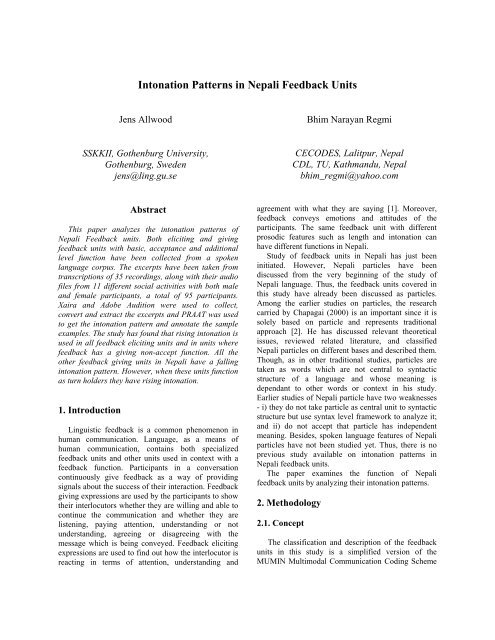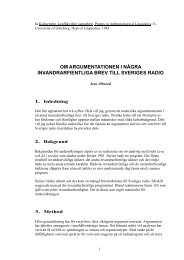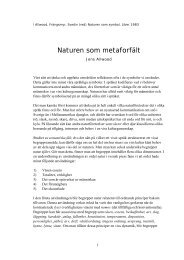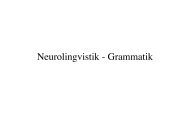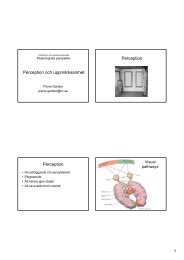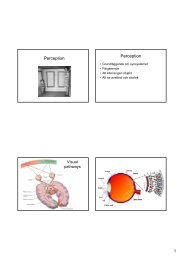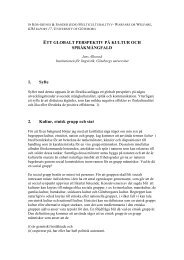Intonation Patterns in Nepali Feedback Units
Intonation Patterns in Nepali Feedback Units
Intonation Patterns in Nepali Feedback Units
Create successful ePaper yourself
Turn your PDF publications into a flip-book with our unique Google optimized e-Paper software.
<strong>Intonation</strong> <strong>Patterns</strong> <strong>in</strong> <strong>Nepali</strong> <strong>Feedback</strong> <strong>Units</strong><br />
Jens Allwood<br />
SSKKII, Gothenburg University,<br />
Gothenburg, Sweden<br />
jens@l<strong>in</strong>g.gu.se<br />
Abstract<br />
This paper analyzes the <strong>in</strong>tonation patterns of<br />
<strong>Nepali</strong> <strong>Feedback</strong> units. Both elicit<strong>in</strong>g and giv<strong>in</strong>g<br />
feedback units with basic, acceptance and additional<br />
level function have been collected from a spoken<br />
language corpus. The excerpts have been taken from<br />
transcriptions of 35 record<strong>in</strong>gs, along with their audio<br />
files from 11 different social activities with both male<br />
and female participants, a total of 95 participants.<br />
Xaira and Adobe Audition were used to collect,<br />
convert and extract the excerpts and PRAAT was used<br />
to get the <strong>in</strong>tonation pattern and annotate the sample<br />
examples. The study has found that ris<strong>in</strong>g <strong>in</strong>tonation is<br />
used <strong>in</strong> all feedback elicit<strong>in</strong>g units and <strong>in</strong> units where<br />
feedback has a giv<strong>in</strong>g non-accept function. All the<br />
other feedback giv<strong>in</strong>g units <strong>in</strong> <strong>Nepali</strong> have a fall<strong>in</strong>g<br />
<strong>in</strong>tonation pattern. However, when these units function<br />
as turn holders they have ris<strong>in</strong>g <strong>in</strong>tonation.<br />
1. Introduction<br />
L<strong>in</strong>guistic feedback is a common phenomenon <strong>in</strong><br />
human communication. Language, as a means of<br />
human communication, conta<strong>in</strong>s both specialized<br />
feedback units and other units used <strong>in</strong> context with a<br />
feedback function. Participants <strong>in</strong> a conversation<br />
cont<strong>in</strong>uously give feedback as a way of provid<strong>in</strong>g<br />
signals about the success of their <strong>in</strong>teraction. <strong>Feedback</strong><br />
giv<strong>in</strong>g expressions are used by the participants to show<br />
their <strong>in</strong>terlocutors whether they are will<strong>in</strong>g and able to<br />
cont<strong>in</strong>ue the communication and whether they are<br />
listen<strong>in</strong>g, pay<strong>in</strong>g attention, understand<strong>in</strong>g or not<br />
understand<strong>in</strong>g, agree<strong>in</strong>g or disagree<strong>in</strong>g with the<br />
message which is be<strong>in</strong>g conveyed. <strong>Feedback</strong> elicit<strong>in</strong>g<br />
expressions are used to f<strong>in</strong>d out how the <strong>in</strong>terlocutor is<br />
react<strong>in</strong>g <strong>in</strong> terms of attention, understand<strong>in</strong>g and<br />
Bhim Narayan Regmi<br />
CECODES, Lalitpur, Nepal<br />
CDL, TU, Kathmandu, Nepal<br />
bhim_regmi@yahoo.com<br />
agreement with what they are say<strong>in</strong>g [1]. Moreover,<br />
feedback conveys emotions and attitudes of the<br />
participants. The same feedback unit with different<br />
prosodic features such as length and <strong>in</strong>tonation can<br />
have different functions <strong>in</strong> <strong>Nepali</strong>.<br />
Study of feedback units <strong>in</strong> <strong>Nepali</strong> has just been<br />
<strong>in</strong>itiated. However, <strong>Nepali</strong> particles have been<br />
discussed from the very beg<strong>in</strong>n<strong>in</strong>g of the study of<br />
<strong>Nepali</strong> language. Thus, the feedback units covered <strong>in</strong><br />
this study have already been discussed as particles.<br />
Among the earlier studies on particles, the research<br />
carried by Chapagai (2000) is an important s<strong>in</strong>ce it is<br />
solely based on particle and represents traditional<br />
approach [2]. He has discussed relevant theoretical<br />
issues, reviewed related literature, and classified<br />
<strong>Nepali</strong> particles on different bases and described them.<br />
Though, as <strong>in</strong> other traditional studies, particles are<br />
taken as words which are not central to syntactic<br />
structure of a language and whose mean<strong>in</strong>g is<br />
dependant to other words or context <strong>in</strong> his study.<br />
Earlier studies of <strong>Nepali</strong> particle have two weaknesses<br />
- i) they do not take particle as central unit to syntactic<br />
structure but use syntax level framework to analyze it;<br />
and ii) do not accept that particle has <strong>in</strong>dependent<br />
mean<strong>in</strong>g. Besides, spoken language features of <strong>Nepali</strong><br />
particles have not been studied yet. Thus, there is no<br />
previous study available on <strong>in</strong>tonation patterns <strong>in</strong><br />
<strong>Nepali</strong> feedback units.<br />
The paper exam<strong>in</strong>es the function of <strong>Nepali</strong><br />
feedback units by analyz<strong>in</strong>g their <strong>in</strong>tonation patterns.<br />
2. Methodology<br />
2.1. Concept<br />
The classification and description of the feedback<br />
units <strong>in</strong> this study is a simplified version of the<br />
MUMIN Multimodal Communication Cod<strong>in</strong>g Scheme
[3]. The follow<strong>in</strong>g table from this scheme presents the<br />
categories used <strong>in</strong> the study.<br />
Table 1. Conceptual framework for feedback units<br />
Function<br />
feature<br />
Giv<strong>in</strong>g<br />
<strong>Feedback</strong><br />
Elicit<strong>in</strong>g<br />
<strong>Feedback</strong><br />
2.2. Data<br />
Specific function<br />
value<br />
Basic Contact/cont<strong>in</strong>uati<br />
on Perception<br />
Understand<strong>in</strong>g<br />
Acceptance Accept<br />
Non-accept<br />
Additional<br />
Emotion<br />
(E)/ Attitude<br />
Happy<br />
Sad<br />
Surprised<br />
Disgusted<br />
Angry<br />
Frightened<br />
Certa<strong>in</strong><br />
Uncerta<strong>in</strong><br />
Interested<br />
Un<strong>in</strong>terested<br />
Disappo<strong>in</strong>ted<br />
Satisfied<br />
Other<br />
Basic EContact/Cont<strong>in</strong>u<br />
ation Perception<br />
Understand<strong>in</strong>g<br />
Additional<br />
emotion<br />
E-<br />
Contact/cont<strong>in</strong>uati<br />
on Perception<br />
Acceptance E-Accept<br />
E-Non-accept<br />
Additional<br />
Emotion/<br />
Attitude<br />
Happy<br />
Sad<br />
Surprised<br />
Disgusted<br />
Angry<br />
Frightened<br />
Certa<strong>in</strong><br />
Uncerta<strong>in</strong><br />
Interested<br />
Un<strong>in</strong>terested<br />
Disappo<strong>in</strong>ted<br />
Satisfied<br />
Other<br />
Short tag<br />
C<br />
P<br />
U<br />
Accept<br />
Nonaccept<br />
E-CPU<br />
C<br />
P<br />
U<br />
-E<br />
E-CP<br />
E-Accept<br />
E-Nonaccept<br />
E-<br />
The study presented <strong>in</strong> this paper is based on the<br />
Spoken Corpus component of the <strong>Nepali</strong> National<br />
Corpus (NNC-SC) [4]. The <strong>Nepali</strong> Spoken Corpus<br />
(NNC-SC) is a part of the NNC that has been created<br />
to study the function of language <strong>in</strong> different social<br />
activities. All the record<strong>in</strong>gs have been made with<br />
ecological validity outside of studio. Unfortunately,<br />
this at times compromised the quality of the record<strong>in</strong>g.<br />
There are 116 audio and audio-video record<strong>in</strong>gs with<br />
phonemic transcripts cover<strong>in</strong>g 17 different social<br />
activities. Altogether, this makes about 32 hours' of<br />
record<strong>in</strong>g, the so far f<strong>in</strong>ished transcriptions of which<br />
conta<strong>in</strong>s about 260 000 words.<br />
The data studied has not been based on statistical<br />
sampl<strong>in</strong>g pr<strong>in</strong>ciples s<strong>in</strong>ce the study is more qualitative,<br />
but we believe the excerpts are representative. The<br />
data presented <strong>in</strong> this study comes from 35 files taken<br />
from 11 recorded, social activities, where we have<br />
balanced male-female participants. The follow<strong>in</strong>g two<br />
tables give an overview of the activities, files, and<br />
participants, etc.<br />
Table 2. Social activities and the number of files<br />
S. N. Activit<br />
y type<br />
Activity name Files<br />
1. 17 Phone 10<br />
2. 1 Shopp<strong>in</strong>g 2<br />
3. 2 Discussion 6<br />
4. 5 Lunch 2<br />
5. 7 Conversation while work<strong>in</strong>g<br />
(weav<strong>in</strong>g, farm<strong>in</strong>g, etc.)<br />
4<br />
6. 9 Hotel 1<br />
7. 12 TV Talk show 2<br />
8. 13 Interview 1<br />
9. 14 Hospital 5<br />
10. 18 Market Place 1<br />
11. 23 Thesis defence 1<br />
Total 35<br />
Table 3. Participants, distribution of excerpts<br />
<strong>Feedback</strong> Acti- Files Parti- Male Female Child Excerp<br />
vitiescipants ts<br />
GFB 11 31 41 20 20 1 74<br />
EFB 5 14 15 6 9 - 21<br />
Total 11 35 48 23 24 1 95<br />
GFB = giv<strong>in</strong>g feedback<br />
EFB = elicit<strong>in</strong>g of feedback<br />
2.3. Procedure<br />
The data excerpts <strong>in</strong> this study have been collected<br />
from phonemically transcribed files us<strong>in</strong>g Xaira [5].<br />
All the files were imported to Xaira, then the wordlist<br />
was generated, the possible feedback items were<br />
selected manually, these words were located aga<strong>in</strong> <strong>in</strong><br />
all the 116 files with Xaira, creat<strong>in</strong>g a concordance<br />
with at least one utterance before and one utterance<br />
after the feedback word. When it is confirmed that the<br />
selected expression has a feedback unit (s<strong>in</strong>gle word,
phrase or repeated), it is marked. The examples with<br />
the shortest utterances before and after were selected<br />
for presentation <strong>in</strong> the paper wherever possible.<br />
Figure 1. Concordance of EFB unit 'pakkaa' <strong>in</strong><br />
Xaira<br />
Audio and Audio-video files correspond<strong>in</strong>g to the<br />
chosen transcribed excerpts were selected for the<br />
analysis of <strong>in</strong>tonation pattern. The files were <strong>in</strong> MPEG<br />
format and needed to be converted <strong>in</strong>to WAVE audio<br />
files to be analyzed with PRAAT [6]. Adobe Audition<br />
has been used to extract sound from audio-video files<br />
and convert audio files to the WAVE format.<br />
The feedback units were extracted from the audio<br />
files with PRAAT.<br />
Figure 2. A view of annotated EFB units <strong>in</strong><br />
PRAAT<br />
3. <strong>Nepali</strong> feedback units<br />
<strong>Nepali</strong> <strong>Feedback</strong> units can be classified <strong>in</strong>to two<br />
broad categories viz. feedback giv<strong>in</strong>g and feedback<br />
elicit<strong>in</strong>g units. These are dealt with separately <strong>in</strong> the<br />
follow<strong>in</strong>g subsections.<br />
3.1. <strong>Feedback</strong> giv<strong>in</strong>g unit<br />
Expressions that can be used to give feedback<br />
(GFB) <strong>in</strong> <strong>Nepali</strong> <strong>in</strong>clude s<strong>in</strong>gle words, phrases, and<br />
repeated word forms. These different units have not<br />
been differentiated here, <strong>in</strong>stead, they have been<br />
analyzed <strong>in</strong> terms of their function. These GFBs are<br />
shown <strong>in</strong> the follow<strong>in</strong>g tables along with a description<br />
of their typical <strong>in</strong>tonation.<br />
Expressions with a basic feedback giv<strong>in</strong>g function<br />
are used by a speaker for establishment and<br />
cont<strong>in</strong>uation of contact and to give <strong>in</strong>formation about<br />
perception and understand<strong>in</strong>g (CPU). CP <strong>in</strong>dicates that<br />
the <strong>in</strong>terlocutor is cont<strong>in</strong>u<strong>in</strong>g contact and perceiv<strong>in</strong>g<br />
the message. CPU <strong>in</strong>dicates that the <strong>in</strong>terlocutor<br />
understands the message as well.<br />
All the <strong>Nepali</strong> GFB Basic CP units presented <strong>in</strong><br />
Table 4 have ris<strong>in</strong>g <strong>in</strong>tonation except halo 'hello'.<br />
However, the equivalent GFB unit hazur 'hello' has<br />
ris<strong>in</strong>g <strong>in</strong>tonation. Table 4 presents the GFB Basic CP<br />
units <strong>in</strong> <strong>Nepali</strong> that have ris<strong>in</strong>g <strong>in</strong>tonation, however,<br />
the exception halo <strong>in</strong>dicates the need of more detailed<br />
description.<br />
Table 4. <strong>Intonation</strong> pattern of GFB Basic, CP<br />
FB Unit <strong>Intonation</strong><br />
haN 'pardon', hazur 'hello', huN 'pardon', haN Ris<strong>in</strong>g<br />
kere 'pardon'<br />
halo 'hello' Fall<strong>in</strong>g<br />
All the <strong>Nepali</strong> GFB Basic CPU units as presented <strong>in</strong><br />
Table 5 have fall<strong>in</strong>g <strong>in</strong>tonation except ang 'mm'. This<br />
<strong>in</strong>dicates a general trend of <strong>Nepali</strong> EFB basic CPU<br />
units to have fall<strong>in</strong>g <strong>in</strong>tonation. However, there is an<br />
exception which needs explanation. The EFB unit ang<br />
'mm' is, unlike other units, used <strong>in</strong> a context where it<br />
has to function as turn holder and also probably with<br />
an OCM (hesitation) rather than ICM function. This<br />
fact <strong>in</strong>dicates that if a speaker <strong>in</strong> giv<strong>in</strong>g feedback uses<br />
a basic CPU unit to hold the turn, it has ris<strong>in</strong>g<br />
<strong>in</strong>tonation otherwise it has fall<strong>in</strong>g <strong>in</strong>tonation.<br />
Table 5. <strong>Intonation</strong> pattern of GFB Basic, CPU<br />
FB Unit <strong>Intonation</strong><br />
hazur 'mm', aN 'mm', e hazur 'O yes', haa Fall<strong>in</strong>g<br />
'mm', aNhaha/aNhaNha 'mm'<br />
ang 'mm' Ris<strong>in</strong>g<br />
When a participant of a conversation accepts or<br />
denies another participant's proposal, idea, order, etc.,<br />
the used feedback units are described as GFB<br />
acceptance or non-acceptance Both of these<br />
subcategories with their <strong>in</strong>tonation patterns are<br />
presented <strong>in</strong> the Table 6 and Table 7 below.<br />
The general trend found here is that the <strong>Nepali</strong> GFB<br />
acceptance units have fall<strong>in</strong>g <strong>in</strong>tonation whereas<br />
<strong>Nepali</strong> GFB non-acceptance units have a ris<strong>in</strong>g<br />
<strong>in</strong>tonation pattern. However, the farewell greet<strong>in</strong>g<br />
baai, which expresses a k<strong>in</strong>d of acceptance, has ris<strong>in</strong>g<br />
<strong>in</strong>tonation. There is also another fact that the same
GFB unit baai 'bye' has fall<strong>in</strong>g <strong>in</strong>tonation <strong>in</strong> another<br />
case (see Table 6). This confusion can also be resolved<br />
with the help of context. The example with ris<strong>in</strong>g<br />
<strong>in</strong>tonation baai 'bye' is the only FB unit used by a child<br />
speaker among the FB units studied here. Thus it can<br />
be taken as non-representative item s<strong>in</strong>ce the child<br />
speech is generally not stabilized.<br />
Table 6. <strong>Intonation</strong> pattern of GFB Accept<br />
FB Unit <strong>Intonation</strong><br />
la 'ok', la baai 'ok bye', m 'yes', haN 'mm', Fall<strong>in</strong>g<br />
baai 'bye', oke 'ok', aN huncha 'yes it is',<br />
m 'yes', ho 'yes, haN Thik cha 'yes its ok',<br />
la ta ni 'ok', aNhaN/ahaN 'no', has 'ok',<br />
dhannebaad 'thanks', has hazur has 'ok ok'<br />
baai 'bye' Ris<strong>in</strong>g<br />
Table 7. <strong>Intonation</strong> pattern of GFB Non-accept<br />
FB Unit <strong>Intonation</strong><br />
aN 'no', aNha 'no', naai/naaiN 'no', aNkha 'no', Ris<strong>in</strong>g<br />
naai/naaiN 'no', ho<strong>in</strong>a 'no'<br />
Additional <strong>Feedback</strong> expressions that are used for<br />
the expression of attitudes and emotions can be<br />
grouped <strong>in</strong>to two categories. These feedback units<br />
function add extra <strong>in</strong>formation related to the thoughts<br />
and feel<strong>in</strong>gs of the <strong>in</strong>terlocutors.<br />
We have studied feedback expressions with<br />
<strong>in</strong>tonation patters correspond<strong>in</strong>g to the attitudes<br />
Certa<strong>in</strong> and Uncerta<strong>in</strong>, Interested and Un<strong>in</strong>terested,<br />
Agreement and Disagreement, Satisfied and Other <strong>in</strong><br />
this paper. We have also studied expressions with the<br />
emotions/attitudes Surprised, and Angry<br />
Both the Certa<strong>in</strong> and Uncerta<strong>in</strong> <strong>Nepali</strong> GFB units<br />
of Additional Attitude have been found to use fall<strong>in</strong>g<br />
<strong>in</strong>tonation pattern as presented <strong>in</strong> the Table 8 and<br />
Table 9 below. However, there is one exception <strong>in</strong> the<br />
GFB Additional Attitude Certa<strong>in</strong> ho 'yes' which has a<br />
ris<strong>in</strong>g <strong>in</strong>tonation pattern. Though it needs to be<br />
exam<strong>in</strong>ed <strong>in</strong> more data to confirm this generalization,<br />
the speaker of this example has been attested to be a<br />
non-native speaker of <strong>Nepali</strong>.<br />
Table 8. <strong>Intonation</strong> pattern of GFB Additional,<br />
Attitude, Certa<strong>in</strong><br />
FB Unit <strong>Intonation</strong><br />
aN cha 'yes it is', aN ekdamai 'yes certa<strong>in</strong>ly', Fall<strong>in</strong>g<br />
ho ta 'yes', hazur aN 'yes yes', ho ta ni 'yes it<br />
is', ho ni 'yes it is', um 'mm', cha ni 'yes it is'<br />
ho 'yes' Ris<strong>in</strong>g<br />
Table 9. <strong>Intonation</strong> pattern of GFB Additional,<br />
Attitude, Uncerta<strong>in</strong><br />
FB Unit <strong>Intonation</strong><br />
khai 'may be', holaa 'may be' Fall<strong>in</strong>g<br />
In <strong>Nepali</strong>, both expressions that show <strong>in</strong>terest and<br />
un-<strong>in</strong>terest have been found to have both fall<strong>in</strong>g and<br />
ris<strong>in</strong>g <strong>in</strong>tonation patterns, however, fall<strong>in</strong>g <strong>in</strong>tonation<br />
pattern is found to be basic to these GFB units. The<br />
justification for this claim is that all the units of<br />
Interested and Un<strong>in</strong>terested GFB with ris<strong>in</strong>g <strong>in</strong>tonation<br />
pattern are either used as turn holders and therefore<br />
probably also have an OCM function, or their second<br />
element is function<strong>in</strong>g as an EFB unit at the same time<br />
<strong>in</strong> the case of phrasal FB units. Ani 'then/and' and aru<br />
'then/other' <strong>in</strong> the examples presented <strong>in</strong> Table 10 and<br />
11 below are function<strong>in</strong>g as feedback giv<strong>in</strong>g and<br />
elicit<strong>in</strong>g units at the same time.<br />
Table 10. <strong>Intonation</strong> pattern of GFB/EFB<br />
Additional, Attitude, Interested<br />
FB Unit <strong>Intonation</strong><br />
aN ho 'yes', zhan 'even', aN 'mm', e la 'O ok', Fall<strong>in</strong>g<br />
haN 'O', pliz 'please', hazur ani 'ok then', e he<br />
'O', e aN aN 'O yes yes'<br />
e ani 'ok then', ho ani 'yes and', e aru 'O then', Ris<strong>in</strong>g<br />
aNha 'mm'<br />
Table 11. <strong>Intonation</strong> pattern of GFB/EFB<br />
Additional, Attitude, Un<strong>in</strong>terested<br />
FB Unit <strong>Intonation</strong><br />
hyaa 'I don't care' Fall<strong>in</strong>g<br />
hyaa 'I do not care' Rais<strong>in</strong>g<br />
Agreement and Disagreement of GFB units of<br />
Additional Attitude also have fall<strong>in</strong>g <strong>in</strong>tonation as <strong>in</strong><br />
the examples m 'yes' (Agreement), naai/naaiN 'no'<br />
(Disagreement).<br />
The <strong>Feedback</strong> unit hai, express<strong>in</strong>g satisfaction, has<br />
been found hav<strong>in</strong>g a ris<strong>in</strong>g <strong>in</strong>tonation pattern.<br />
Similarly, the unit ThikThaak 'f<strong>in</strong>e', express<strong>in</strong>g<br />
satisfaction of positive evaluation, also has fall<strong>in</strong>g<br />
<strong>in</strong>tonation.<br />
The FB units express<strong>in</strong>g Surprised have been found<br />
to have a fall<strong>in</strong>g <strong>in</strong>tonation pattern. However, there<br />
were two exceptional cases where the FB unit also<br />
functions as a turn holder at the same time. They have<br />
ris<strong>in</strong>g <strong>in</strong>tonation. Thus, the general trend for FB units<br />
express<strong>in</strong>g surprise is that they have fall<strong>in</strong>g <strong>in</strong>tonation<br />
<strong>in</strong> <strong>Nepali</strong>. The examples of GFB Additional Emotion<br />
Surprised are presented <strong>in</strong> Table 12 below.<br />
Table 12. <strong>Intonation</strong> pattern of GFB Additional,<br />
Emotion, Surprised<br />
FB Unit <strong>Intonation</strong><br />
abi 'wow', baaphre 'it is very strange', lau Fall<strong>in</strong>g<br />
'wow', lau 'wow'<br />
e 'O', laa 'O' Ris<strong>in</strong>g<br />
For GFB the additional emotion, anger; um la la<br />
'ok' also have fall<strong>in</strong>g <strong>in</strong>tonation.
3.2. <strong>Feedback</strong> elicit<strong>in</strong>g units<br />
The behavior and types of feedback elicit<strong>in</strong>g units<br />
(EFB) are similar to GFB, where EFBs elicit feedback<br />
from the <strong>in</strong>terlocutor and GFBs provide feedback to<br />
the <strong>in</strong>terlocutor.<br />
EFBs <strong>in</strong> <strong>Nepali</strong> exist as s<strong>in</strong>gle words and phrasal<br />
forms. The EFBs have a ris<strong>in</strong>g <strong>in</strong>tonation pattern<br />
except for kyaa 'is it? . Thus, ris<strong>in</strong>g <strong>in</strong>tonation is<br />
typical for <strong>Nepali</strong> EFB units. As <strong>in</strong>dicated above,<br />
EFBs <strong>in</strong> <strong>Nepali</strong> can be classified similarly to what has<br />
been suggested above for GFBs. However, this seems<br />
unnecessary s<strong>in</strong>ce all the EFbs have same <strong>in</strong>tonation<br />
pattern, i.e., ris<strong>in</strong>g <strong>in</strong>tonation. Therefore, all the <strong>Nepali</strong><br />
EFBs have been presented <strong>in</strong> a s<strong>in</strong>gle table together<br />
with their emotional/attitud<strong>in</strong>al functions. Table 13<br />
below shows the examples found.<br />
Table 13. <strong>Nepali</strong> EFB units and <strong>in</strong>tonation pattern<br />
FB unit FB function Int.<br />
la 'ok?' EFB, Acceptance, Accept R<br />
hai 'please' EFB, Acceptance, Accept R<br />
hazur 'pardon' EFB, Basic, CPU R<br />
ho 'is it?' EFB, Additional, Attitude, Certa<strong>in</strong> R<br />
pakkaa<br />
'sure?'<br />
EFB, Additional, Attitude, Certa<strong>in</strong> R<br />
ni 'is it?' EFB, Additional, Attitude, Certa<strong>in</strong> R<br />
kyaa ho EFB, Additional, Attitude, Certa<strong>in</strong> R<br />
Thyaakkai<br />
'exactly'<br />
EFB, Additional, Attitude, Intersted R<br />
ni 'is it?' EFB, Additional, Attitude, Certa<strong>in</strong> R<br />
aN ho 'O is EFB, Additional, Attitude, Certa<strong>in</strong> R<br />
it?'<br />
Thik cha 'ok?' EFB, Acceptance, Accept R<br />
kaaN 'where' EFB, Basic, CP R<br />
kyaa 'is it?' EFB, Additional, Attitude, Certa<strong>in</strong> F<br />
e ho 'O is it?' EFB, Additional, Attitude, Interested R<br />
ho ra 'is it?' EFB, Additional, Emotion, surprised R<br />
haaN 'pardon' EFB, Basic, CPU R<br />
aru 'any EFB, Additional, Attitude, Interested R<br />
other?'<br />
haN 'ok?' EFB, Acceptance, Accept R<br />
hagi EFB, Acceptance, Accept R<br />
4. Multiple functions of the FB units<br />
As has been discussed above, <strong>Nepali</strong> FBs have<br />
multiple functions. In some cases, their <strong>in</strong>tonation<br />
pattern changes as they take on different function, but<br />
this is not always true. Many of the FB units have<br />
multiple functions <strong>in</strong> the same <strong>in</strong>tonation pattern.<br />
However, this needs more detailed and <strong>in</strong> depth studies<br />
for a better description of FB units <strong>in</strong> <strong>Nepali</strong>. Some of<br />
the FB units with multiple functions are presented <strong>in</strong><br />
Table 14. However, the list is not exhaustive.<br />
Table 14. <strong>Nepali</strong> FB units with multiple<br />
mean<strong>in</strong>g/function and <strong>in</strong>tonation patterns<br />
FB Unit Function Int<br />
hazur 'mm' GFB Basic, CPU F<br />
hazur 'hello' GFB Basic, CPU R<br />
hazur 'pardon' EFB Basic, CPU R<br />
aN 'mm' GFB Basic, CPU F<br />
aN 'mm' GFB Additional, Attitude, Interested F<br />
aN 'no' GFB Acceptance, Non-accept F<br />
la 'ok?' EFB, Acceptance, Accept F<br />
la 'ok' GFB Acceptance, Accept F<br />
Apart from the complexities regard<strong>in</strong>g the function<br />
of the feedback units <strong>in</strong> <strong>Nepali</strong> mentioned above, we<br />
can see that some units can function as GFB and EFB<br />
at the same time, e.g. the FB unit hazur, mean<strong>in</strong>g<br />
'pardon' is a GFB with a basic CPU function which can<br />
modify its function as follows: hazur <strong>in</strong>forms the<br />
<strong>in</strong>terlocutor that s/he has established contact and that<br />
someth<strong>in</strong>g has been said but that it cannot be perceived<br />
or that it has been perceived it but cannot be<br />
understood. In this way, hazur (pardon) becomes an<br />
EFB <strong>in</strong>form<strong>in</strong>g the <strong>in</strong>terlocutor that the speaker is<br />
ask<strong>in</strong>g for the <strong>in</strong>formation <strong>in</strong> the preced<strong>in</strong>g utterance<br />
that s/he could not grasp.<br />
5. Conclusion<br />
Our study shows that <strong>Nepali</strong> feedback units can be<br />
used for basic feedback and acceptance as well as for<br />
additional emotions and attitudes. The basic feedback<br />
CP units, <strong>in</strong> general, have a ris<strong>in</strong>g <strong>in</strong>tonation pattern<br />
whereas basic CPU feedback units generally have<br />
fall<strong>in</strong>g <strong>in</strong>tonation pattern. The exceptions to these<br />
patterns, that we have found, make functional sense<br />
and can be described. <strong>Feedback</strong> giv<strong>in</strong>g units with an<br />
accept<strong>in</strong>g function have a general tendency to have an<br />
fall<strong>in</strong>g <strong>in</strong>tonation pattern whereas feedback giv<strong>in</strong>g<br />
units with an non-accept<strong>in</strong>g function have a ris<strong>in</strong>g<br />
<strong>in</strong>tonation pattern.<br />
<strong>Feedback</strong> express<strong>in</strong>g certa<strong>in</strong>ty or uncerta<strong>in</strong>ty has a<br />
fall<strong>in</strong>g <strong>in</strong>tonation pattern, with some expla<strong>in</strong>able<br />
exceptions. FB units express<strong>in</strong>g <strong>in</strong>terest and un-<strong>in</strong>terest<br />
have fall<strong>in</strong>g <strong>in</strong>tonation. However, if a FB unit<br />
functions as a turn holder, often with a simultaneous<br />
OCM function, it has a ris<strong>in</strong>g <strong>in</strong>tonation. <strong>Units</strong><br />
express<strong>in</strong>g agreement and disagreement have fall<strong>in</strong>g<br />
<strong>in</strong>tonation. GFB units express<strong>in</strong>g satisfaction, surprise<br />
and anger also have fall<strong>in</strong>g <strong>in</strong>tonation. GFB units<br />
express<strong>in</strong>g surprise and GFB units express<strong>in</strong>g anger<br />
both have fall<strong>in</strong>g <strong>in</strong>tonation. However, units with<br />
surprise have ris<strong>in</strong>g <strong>in</strong>tonation when they are also turn<br />
holders.
All the EFB units <strong>in</strong> <strong>Nepali</strong> have ris<strong>in</strong>g <strong>in</strong>tonation<br />
pattern.<br />
F<strong>in</strong>ally, <strong>Nepali</strong> feedback units sometimes have<br />
multiple mean<strong>in</strong>gs/functions, and <strong>in</strong>tonation patterns<br />
that are complex to describe.<br />
10. References<br />
[1] [3] J. Allwood, L. Cerrato, L. Dybkjaer, K. Jok<strong>in</strong>en, C.<br />
Navarretta and P. Paggio, "The MUMIN multimodal cod<strong>in</strong>g<br />
scheme". NorFa yearbook 2005.<br />
[2] U. P. Bajgai, "Particles of <strong>Nepali</strong>", M.A. dissertation,<br />
Central Department of L<strong>in</strong>guistics, Tribhuvan University,<br />
Kathmandu, 2000.<br />
[4] Yogendra P. Yadava, Andrew Hardie, Ram Raj Lohani,<br />
Bhim N. Regmi, Srishtee Gurung, Amar Gurung, Tony<br />
McEnery, Jens Allwood and Pat Hall, "Construction and<br />
annotation of a corpus of contemporary <strong>Nepali</strong>", Corpora<br />
Vol. 3 (2), Ed<strong>in</strong>burg University Press, UK, 2008, pp. 213–<br />
225.<br />
[5] www.xaira.org<br />
[6] www.praat.org<br />
.


